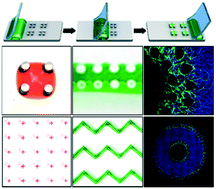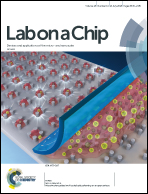Microstructure guided multi-scale liquid patterning on an open surface†
Abstract
Liquid patterning is a quintessential aspect in cell-based screening. While there are a variety of methods to handle microliquids utilizing surface treatments, complex microfluidic systems, and automated dispensing, most of the stated methods are both expensive and difficult to implement. Here, we present a fast multi-scale microliquid-patterning method on an open surface using embossed microstructures without surface modification. Arrays of micropillars can trap microliquids when a bulk drop is swept by an elastic sweeper on polystyrene (PS) substrates. The patterning mechanism on a basic form of a 2 × 2 rectangular array of circular pillars is analyzed theoretically and verified with experiments. Nanoliter-to-microliter volumes of liquids are patterned into various shapes by arranging the pillars based on the analysis. Furthermore, an array of geometrically modified pillars can capture approximately 8000 droplets on a large substrate (55 mm × 55 mm) in one step. Given the simplistic method of wipe patterning, the proposed platform can be utilized in both manual benchtop and automated settings. We will provide proof of concept experiments of single colony isolation using nanoliter-scale liquid patterning and of human angiogenic vessel formation using sequential patterning of microliter-scale liquids.

- This article is part of the themed collection: Lab on a Chip Recent HOT Articles


 Please wait while we load your content...
Please wait while we load your content...